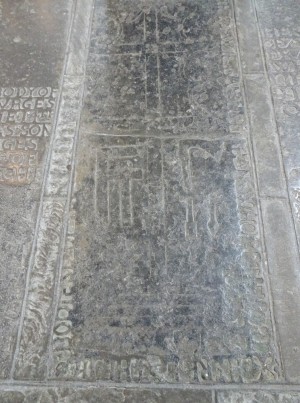GA-STNL-0310
) +HERE LYETHE • THE ?[IH] • (YE) BODIESE — OF WITH • HIS • WIF IVANI • MVN[-]HAN • WHOM • THE • LORD RE —?D — [date?]
The slab was originally a long, trapezoidal one but it has been trimmed to a roughly rectangular shape. As a result of this the section of the Ins. along the top and on the upper three quarters of the left side have been cut away. The slab bears a large, incised, double-armed cross on a moulded base very similar to that on No. 308. The vocational marks of a cooper or carpenter flank the lower part of the cross-shaft. On the right is a wide-bladed adze or axe and beneath this a spearhead-shaped chisel which may represent a point or pitcher. (This would be more suited to masonry than carpentry work). Alongside this is another item, presumably a wide-bladed chisel (a boaster or querk). On the left of the shaft are a T-square and a set square. The set square has an s-shaped indentation at each end. The cross is double-armed and like No. 308 has its arms linked by pairs of curved lines. The terminals of both the cross and the semi-circular features between the arms have fleurs-de-lis terminals. A small decorative device, now very worn, occurs at each of the junctions of the cross-arms and shaft. The upper-most device seems to be a small lozenge cut in false relief. The lower device is too damaged and worn to interpret. The slab has broken across completely and repaired in modem cement. The small "bird-like" feature in the lower right comer of the Ins. appears to be an "E" or a symbol representing "Ye" (ie. "the").



